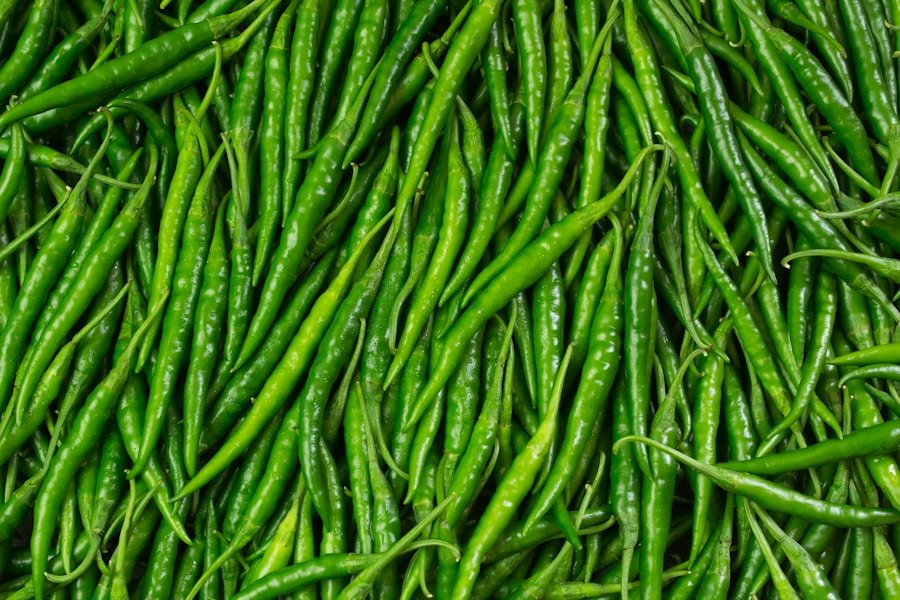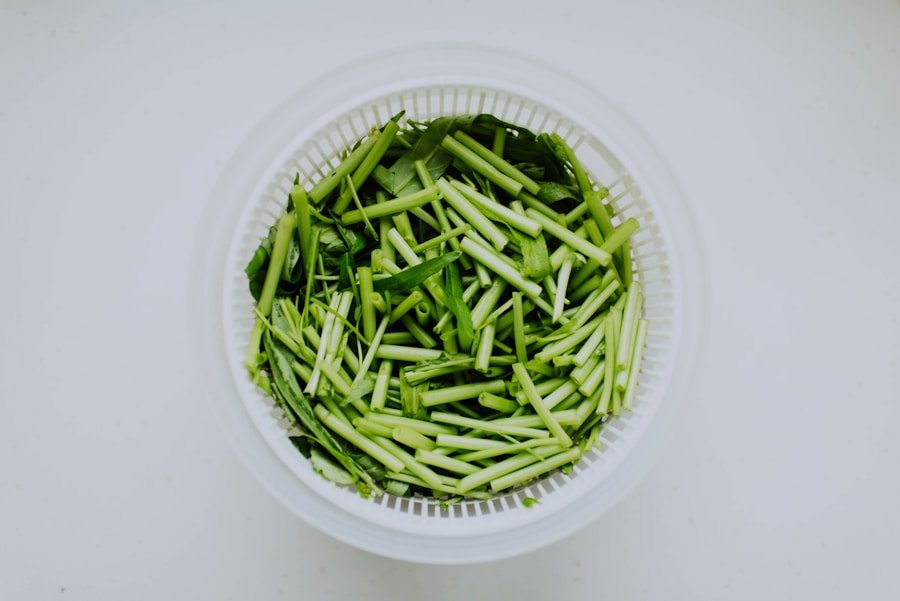Blanching green beans is a culinary technique that serves multiple purposes, enhancing both the flavor and texture of this beloved vegetable. When done correctly, blanching preserves the vibrant green color of the beans, making them visually appealing on the plate. This process also helps to lock in nutrients, ensuring that the beans retain their health benefits.
The quick cooking method of blanching halts enzymatic activity, which can lead to loss of flavor and color over time. This is particularly important for those who wish to store green beans for later use, as it extends their shelf life while maintaining their quality. Moreover, perfectly blanched green beans provide a delightful crunch that elevates various dishes.
The brief exposure to boiling water softens the beans just enough to make them tender yet still crisp, creating a satisfying texture that contrasts beautifully with other ingredients in a dish. Whether served as a side, incorporated into salads, or used in casseroles, the quality of blanched green beans can significantly influence the overall dining experience. Their bright color and fresh taste can transform a simple meal into something extraordinary, making them a staple in many kitchens.
Key Takeaways
- Perfectly blanched green beans are essential for maintaining their vibrant color, crisp texture, and fresh flavor.
- When choosing green beans, look for ones that are bright green, firm, and free from blemishes or spots.
- Before blanching, trim the ends of the green beans and cut them into uniform lengths for even cooking.
- The blanching process involves boiling the green beans for a short period of time, followed by immediate cooling in ice water to stop the cooking process.
- To test for doneness, taste a green bean for the desired texture and color.
Choosing the Right Green Beans
Selecting the right variety of green beans is crucial for achieving optimal results when blanching. There are several types of green beans available, each with its unique characteristics. Common varieties include French green beans (haricots verts), which are slender and tender, and standard green beans, which are thicker and have a more robust flavor.
When choosing green beans, look for those that are bright green in color, firm to the touch, and free from blemishes or soft spots. Freshness is key; beans that are past their prime may have a dull appearance and a tough texture, which can negatively impact the final dish. In addition to visual inspection, consider the seasonality of green beans.
Peak season typically runs from late spring through early fall, during which time they are most flavorful and abundant. Purchasing beans from local farmers’ markets or grocery stores that prioritize seasonal produce can yield better quality. If possible, opt for organic varieties to avoid pesticide residues and support sustainable farming practices.
The right choice of green beans not only enhances the taste but also contributes to the overall healthfulness of your meals.
Preparing the Green Beans for Blanching

Preparation is a vital step in the blanching process that can significantly affect the outcome. Begin by washing the green beans thoroughly under cold running water to remove any dirt or debris. This step is essential for ensuring that the beans are clean and safe to eat.
After rinsing, trim the ends of each bean; this involves cutting off the stem end and any other tough or discolored parts. Some cooks prefer to remove both ends for aesthetic reasons, while others may leave the tail end intact for a more rustic presentation. Once trimmed, it’s beneficial to sort the beans by size.
Uniformity in size ensures that all beans will cook evenly during blanching. If you have a mix of thin and thick beans, consider cutting the thicker ones in half to match the size of their thinner counterparts. This attention to detail not only improves cooking consistency but also enhances the visual appeal of your final dish.
After sorting and trimming, gather all your prepared beans together and have them ready for the blanching process.
The Blanching Process
| Blanching Process Metrics | Value |
|---|---|
| Temperature | 60-100°C |
| Time | 1-10 minutes |
| Water Consumption | 5-10 liters per kg of product |
| Energy Consumption | 0.1-0.5 kWh per kg of product |
| Effect on Nutrients | Reduces vitamin content by 15-25% |
The blanching process itself is relatively straightforward but requires careful attention to timing and temperature. Begin by bringing a large pot of salted water to a rolling boil; the salt not only enhances flavor but also helps maintain the vibrant color of the beans during cooking. Once the water reaches a boil, add the prepared green beans in batches if necessary; overcrowding the pot can lower the water temperature and lead to uneven cooking.
Blanching typically lasts between two to five minutes, depending on the thickness of the beans and your desired level of tenderness. For French green beans, two to three minutes is usually sufficient, while standard green beans may require closer to four or five minutes. It’s essential to keep an eye on the clock during this stage; overcooking can result in mushy beans that lose their appealing crunch and bright color.
Stirring gently during blanching can help ensure even cooking and prevent any beans from clumping together.
Testing for Doneness
Determining when your green beans are perfectly blanched is crucial for achieving that ideal texture. One effective method is to taste a bean after about two minutes of cooking; it should be tender yet still have a slight snap when bitten into. If you prefer your beans on the firmer side, you may want to err on the side of caution and remove them from boiling water sooner rather than later.
Conversely, if you enjoy a softer texture, you can leave them in for an additional minute or two. Another way to test for doneness is by observing their color and texture. Perfectly blanched green beans should be bright green and glossy, indicating that they have retained their chlorophyll during cooking.
If they appear dull or olive-colored, they may have been overcooked. Additionally, you can check for tenderness by gently pressing a bean between your fingers; it should yield slightly without being mushy. This combination of visual cues and tactile testing will help ensure that your green beans are cooked just right.
Cooling and Draining the Green Beans

Once your green beans have reached the desired level of doneness, it’s time to cool them down rapidly to halt the cooking process—a technique known as shocking. Prepare an ice bath by filling a large bowl with ice and cold water before you begin blanching. As soon as you remove the beans from boiling water, immediately transfer them into the ice bath using a slotted spoon or a strainer.
This step is critical for preserving their vibrant color and crisp texture. Allow the green beans to sit in the ice bath for about five minutes or until they are completely cooled. This rapid cooling not only stops further cooking but also helps set their bright color, making them more visually appealing when served.
After cooling, drain the beans thoroughly in a colander or on paper towels to remove excess moisture before incorporating them into your dishes or storing them for later use.
Incorporating Blanched Green Beans into Salads
Blanched green beans are an excellent addition to salads, providing both flavor and texture that can elevate any dish. Their crispness pairs well with various ingredients, making them versatile enough for different types of salads—from light summer fare to hearty winter options. For instance, consider tossing blanched green beans with cherry tomatoes, red onion, and feta cheese for a refreshing Mediterranean-inspired salad drizzled with olive oil and balsamic vinegar.
Another delightful option is to create a warm salad featuring blanched green beans alongside roasted potatoes and grilled chicken. The combination of warm ingredients with cool greens creates an appealing contrast that enhances both flavor and presentation. Adding nuts such as toasted almonds or walnuts can introduce an additional layer of crunch while providing healthy fats.
The possibilities are endless; blanched green beans can be incorporated into grain salads with quinoa or farro or even used as a topping for pizza or flatbreads.
Tips for Storing Blanched Green Beans
Proper storage techniques are essential for maintaining the quality of blanched green beans after preparation. If you plan to use them within a few days, store them in an airtight container in the refrigerator. They should remain fresh for up to five days when stored correctly; however, it’s best to consume them sooner for optimal flavor and texture.
For longer storage options, consider freezing blanched green beans. After cooling and draining them thoroughly, spread them out in a single layer on a baking sheet lined with parchment paper and place them in the freezer until frozen solid—this prevents them from clumping together in storage. Once frozen, transfer the beans into freezer-safe bags or containers, removing as much air as possible before sealing.
Properly stored blanched green beans can last up to six months in the freezer without significant loss of quality. When ready to use them, there’s no need to thaw; simply toss them directly into your cooking dish or salad for added convenience and nutrition.
If you’re looking to upgrade your kitchen appliances, you may want to check out this article on the 5 Most Compact Microwaves for Your Office Kitchen. These microwaves are perfect for small spaces and can help make cooking and reheating meals a breeze. And if you’re interested in adding more smart technology to your kitchen, you might also enjoy reading about the 3 Best Smart Pressure Cookers with Wi-Fi. These high-tech appliances can help you cook meals faster and more efficiently. And if you’re in need of a heavy-duty doorstop for your kitchen or any other room in your home, be sure to check out the 5 Top Doorstops for Heavy Doors. These doorstops are durable and reliable, making them a great addition to any home.
FAQs
What is blanching?
Blanching is a cooking technique that involves briefly immersing food in boiling water, then quickly cooling it in ice water to stop the cooking process.
Why should green beans be blanched for salads?
Blanching green beans helps to preserve their vibrant green color, improve their texture, and remove any dirt or impurities.
How do you blanch green beans for salads?
To blanch green beans for salads, bring a pot of water to a boil, add the green beans, and cook for 2-3 minutes. Then, quickly transfer the green beans to a bowl of ice water to cool them down.
Can blanched green beans be prepared in advance for salads?
Yes, blanched green beans can be prepared in advance for salads. After blanching, dry the green beans thoroughly and store them in an airtight container in the refrigerator for up to 3 days.
Can blanched green beans be frozen for later use in salads?
Yes, blanched green beans can be frozen for later use in salads. After blanching, transfer the green beans to a bowl of ice water to cool them down, then dry them thoroughly and store them in a freezer-safe bag or container for up to 3 months.


2 thoughts on “Perfectly Blanched Green Beans for Salads: A Step-by-Step Guide”